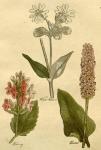Bistort.
A VERY beautiful wild plant: it grows in our meadows, and, when in flower, in May and June, is very conspicuous, as well as very elegant in its appearance. It is about a foot and a half high; the leaves are broad and beautiful, and the flowers grow in a thick spike or ear, at the top of the stalks, and are of a bright red colour. There rise immediately from the root a number of large and beautiful leaves, long, broad, and of a fine green colour. The stalks on which they stand, have also a rim of the leaf running down them; the stalks are round, firm, and erect, of a pale green, and have two or three leaves, like the others, but smaller, on them, placed at distances. The spike of the flowers is as long, and as thick as a man's thumb: the root is thick and contorted, blackish on the outside, and red within.
If we minded our own herbs, we should need fewer medicines from abroad. The root of bistort is one of the best astringents in the world: not violent, but sure. The time of gathering it is in March, when the leaves begin to shoot. String several of them on a line, and let them dry in the shade. The powder or decoction of them, will stop all fluxes of the belly, and is one of the safest remedies known for overflowings of the menses. They are also good in a diabetes. The use of this root may be obtained without danger till it effects a perfect cure.


